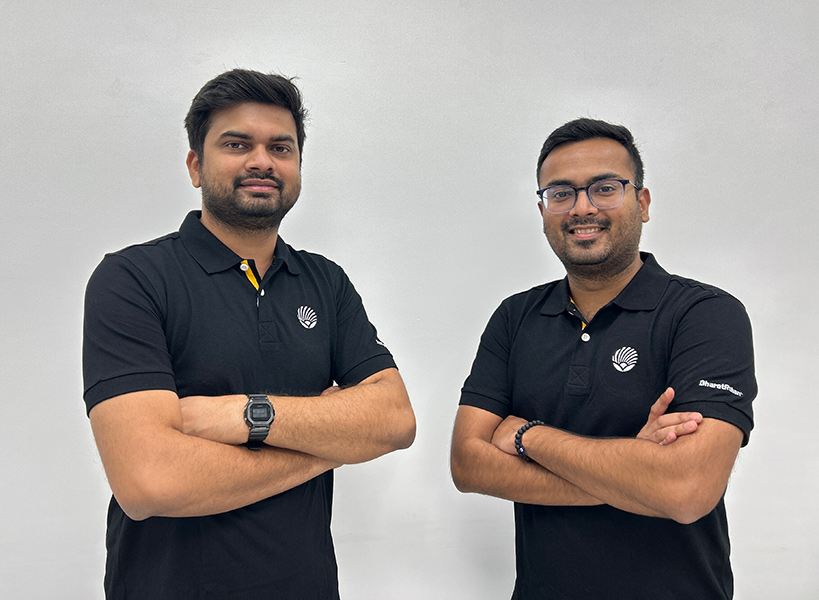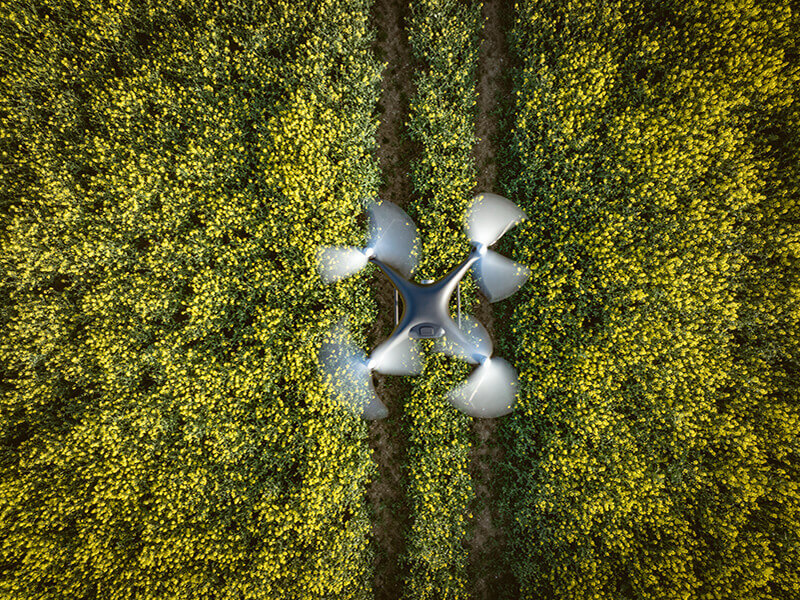With hyperspectral images of farm captured from drones, BharatRohan, an agritech startup, is helping farmers diagnose and treat diseases and pest attacks early.
 TR Vivek
TR Vivek 
With hyperspectral images of farm captured from drones, BharatRohan, an agritech startup, is helping farmers diagnose and treat diseases and pest attacks early.
 TR Vivek
TR Vivek
Amandeep Panwar, 30, and Rishabh Choudhary, 31, first set foot on a farm in 2015. As students in an aeronautical engineering graduate course at a Lucknow college, farms in a village nearby offered the vast open spaces to fly a drone for their final year project. The friendship they struck up in college has resulted in BharatRohan, a startup with revenue of nearly Rs 20 crore in the frontier space of precision agriculture technology.
Founded in 2016, immediately after Panwar and Choudhary graduated, BharatRohan uses hyperspectral imaging, one of the most advanced remote sensing tools to capture warning signals about pest attacks, disease outbreaks and nutrition deficiency in crops at a very early and actionable stage. “Remedial action at this early stage helps farmers eliminate crop losses. It can be one of the most important innovations in agricultural early warning systems. The potential is humungous,” says Kondapi Srinivas, principal scientist at Indian Council of Agriculture Research’s (ICAR) National Academy of Agricultural Research Management (NAARM) in Hyderabad that incubated the start-up.
The power of precision
Every year India loses in excess of 15% of its farm output worth about $40 billion to diseases, pests and climate related crop stress.
BharatRohan’s drones are fitted with hyperspectral imaging (HSI) cameras that film the farmland every week to ten days. The technology and the firm’s proprietary algorithms can decipher the miniscule colour changes occurring in the plants due to different biochemical changes. For instance, a pomegranate plant infested with bacterial blight develops red-brown spots on the leaves. To a naked eye, these spots are visible only after 7-10 days of infestation. But with HSI, the infestation can be identified in the very early stages, and the problem can be treated with precision without any significant damage.

BharatRohan not only identifies the problems but also suggests the fixes. “The early-stage diagnosis of the biochemical changes in crops helps us create prescription on maps highlighted with the critical zones. An actionable advisory is given to the farmers. Our executives help farmers in its implementation. With precision and early diagnosis, farmers can apply the pesticides in the tract of land. They save on inputs and gain yields,” says Panwar, CEO, BharatRohan.
Filming the farms
Hyperspectral imaging is a technique that analyses a wide spectrum of light instead of just assigning primary colours (red, green, blue) to each pixel. The light striking each pixel is broken down into many different spectral bands in order to provide more information on what is imaged. The unique colour signature of an individual object can be detected. Unlike other optical technologies that can only scan for a single colour, HSI can distinguish the full colour spectrum in each pixel. BharatRohan can currently collect plant level and row level data at 5 cm/pixel resolution.
The use of drones is a big part of the Indian government’s push towards precision farming techniques. Under the Viksit Bharat scheme, the government would fund 15,000 rural women self-help groups (SHG) to the tune of 80% of the cost of a drone. The drones would be operated by trained women drone pilots called drone didis who are part of the SHG. Local farmers would be able to rent the drones for spraying fertilizer, sowing and monitoring crop health.
The interactions with farmers in the days of flying drones over their fields, helped Panwar and Choudhary learn first-hand about the damage caused by pests. They looked for ways to use their love for drones to help farmers. With a bit of research, they zeroed in on hyperspectral imaging, but it was too complex an area for two freshly-minted engineering graduates to venture into.
The mint experiment
The duo made cold calls to several experts in the field in India and overseas. They connected on Linkedin with Keshav Singh, an IIT-Mumbai alumnus and a post-doctoral researcher at University of California, Davis, specialising in the use of remote sensing technology and the use of unmanned aerial systems in precision agricultural applications. Singh was roped in early as partner.
Guidance, mentorship, and seed money came from ICAR’s a-IDEA incubator and CSIR’s Lucknow-based Central Institute of Medicinal and Aromatic plants (CIMAP). Manoj Semwal, a senior scientist at CIMAP, helped BharatRohan create the spectral libraries for various crops and their diseases, starting with mint, potato and paddy, the three major crops in the Uttar Pradesh’s Barabanki district. The spectral library is a vast database that includes information about colour changes of a healthy plant grown in ideal conditions and those with specific diseases like the rust fungus in mint. Images from a farmer’s field can be juxtaposed with those from the library to precisely diagnose the occurrence of a disease, its stage and the nutritional status of the crop.
But every crop needs its own spectral library. To add information on a wide variety of crops, the company is working with the International Crops Research Institute for the Semi-Arid Tropics (ICRISAT), a Hyderabad-headquartered multilateral research organisation that works on millets and pulses that are the mainstay of farmers in the drylands of India and Africa.
The company’s drones can scour more than 10,000 acres of farmland every fortnight. BharatRohan uses artificial intelligence (AI) and machine learning (ML) based tools to build proprietary models of analysis.
CIMAP introduced the two entrepreneurs to some 300 “progressive” mint farmers in region who were part of its own network. Having won a clutch of entrepreneurship grants from Indian School of Business (ISB), Rabobank and Government of India, BharatRohan began operations as a subscription-based service for the farmers in Barabanki in 2017.
Uttar Pradesh alone accounts for almost 70% of the global mint production. Natural mint oil finds extensive use in pharmaceutical, food and confectionery industries. Boosting yields Rakesh Kumar, an aromatic herbs farmer in the Fatehpur tehsil of Barabanki, a BharatRohan partner since 2017, says he and his fellow farmers were initially dismissive of the two youngsters who claimed to increase yields with the help of drones.
“After the results of the first 90-day mint crop, we had no doubt that it worked,” he says. According to Rakesh, the income from his nine acres of land where he grows mint, lemongrass, potato and paddy, has gone up 25% to Rs 12 lakh from Rs 9 lakh in the years he’s been working with the firm. Plus, he can save around Rs 3,500 per acre every crop cycle on inputs such as fertiliser and pesticides. For the advisory based on BharatRohan’s technology, farmers would pay 3% of their produce sales to the company.
But Panwar and Choudhary quickly realised that a business that depended entirely on getting farmers to pay might not be sustainable in India. In 2019, BharatRohan changed course to become an agriculture platform company that works with farmers from the sowing stage to post-harvest sales.
Will farmers pay up?
“Currently, we work with 19,000 farmers across 50,000 acres in six different states on a variety of crops. We adopt a farmer-friendly pricing model, charging based on the crop season. For instance, farmers cultivating crops over 3-4 months are charged approximately Rs 399 per acre per season. This approach ensures affordability for the farmers,” explains Panwar.
Using the data from drones, BharatRohan can offer farmers real advice through Whatsapp chatbots and on-field agronomists on caring for the crops.
The access to highly accurate data on fertilizer and chemical use by the farmers in its network makes it attractive for large food buyers to partner with the company. This also helps farmers with good quality produce that adheres to prescribed pesticide and chemical residue levels command a premium.
“In India, unlike start-ups in other sectors, ag-tech companies, even if they have a strong and scalable technology platform, find it very hard to raise venture capital funding for various reasons. Primarily, it is due to the investor fears about the uncertainties in India’s agriculture. But globally, given the stress on resources, high-tech precision farming is the next big thing. Innovations like BharatRohan will be the future,” says ICAR-NAARM’s Srinivas.